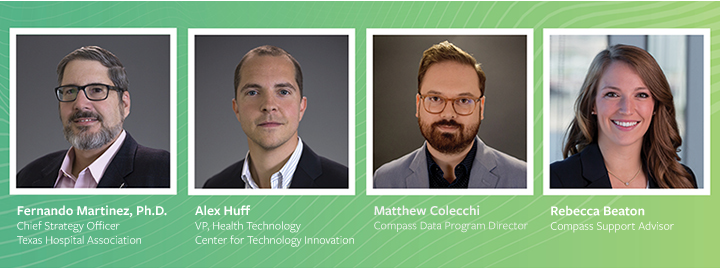Advocacy is often associated with the organized support of policies and legislation enacted at the local, state or federal level to protect a group’s interest. For the Texas Hospital Association, advocacy extends even beyond the bounds of the state and U.S. capitols to a frontier not yet fully explored: health care technology.
In THA’s Center for Technology Innovation (CTI), a small group of health care technology professionals advocate for Texas hospitals by vetting some of the many emerging technologies that are potential solutions to members’ needs in the health care technology space.
Vetting the technology is only one step. CTI has developed a comprehensive feedback loop that involves staff, senior leadership and regional ambassadors to gauge members’ current and future technology needs.
“Recognizing that our member hospitals have a huge dependence on technology, and that THA’s engagement with members in the area of technology was essentially non-existent, we forged a plan to change that,” says Fernando Martinez, Ph.D., chief strategy officer at THA. “The Center for Technology Innovation was conceived as a center of excellence focused on technology with the dual goal of raising our member engagement and increasing the presence of members’ voices in THA’s work.”
CTI is a division of the Texas Hospital Association Foundation and is primarily managed by two health care technology experts, Fernando Martinez and Alex Huff, vice president of health technology.

A New Type of Advocacy
Founded in 2016 by Martinez, a former hospital chief information officer with over 40 years in the industry, CTI was created to champion Texas hospitals in the ever-changing health care technology sector. A sector that grew from a secondary priority to a core component in every aspect of operating a successful hospital.
“We saw the need for a formal initiative around technology,” says Ted Shaw, president and CEO of THA. “Hospitals need a dedicated advocate to help them solve the pain points where IT is concerned.”
In 1999, the U.S. Institute of Medicine released a landmark report, “To Err is Human: Building a Safer Health System.” The report highlighted the startling prevalence of fatal medical errors in the U.S. and asserted the problem is not bad people in health care, rather bad systems that need to be made safer. The following 2001 report, “Crossing the Quality Chasm,” called for using information technology as a key first step in transforming and changing the health care environment to achieve better and safer care.
The subsequent decade created burgeoning opportunities to modernize the United States’ health care industry by incentivizing its development and implementation. For Martinez, who spent the entirety of his career finding meaningful ways to implement emerging technologies in the health care industry, this transition seemed organic and apparent.
“In 1997, during the significant shift from manual, paper-driven health care processes to technology and automation, I was asked to transition from the role of senior finance director to a senior director in IT. I eventually ended up in my first chief information officer role,” said Martinez.
Over the next 20 years, Martinez became an adept turnaround CIO, instilling prolific expertise to health care organizations lacking a clear IT mission – a strategy that Martinez brought to CTI.
Current Initiatives
In its few short years of its existence, CTI made significant strides to identify nascent technologies and bring them to Texas hospitals to help providers care for their patients. In some cases, Texas hospitals were the first to adopt and implement these new technologies, proving that Texas hospitals remain at the forefront of innovation.
Compass
In 2015, CTI re-launched a paper-based legacy data analytics program to a software-driven data analytics program. This new Compass program existed to help Texas hospitals navigate the evolving health care landscape with data collection, analytics and regulatory compliance.
Using Stratasan’s Launch Pathway and Physician Loyalty programs, Compass helps hospital administrators get better marketplace insights and adhere to compliance requirements set forth by Texas Health Care Information Collection.
“We use Compass to determine what services are leaving our community for treatment,” says Susan Turley, CEO of Doctor’s Hospital at Renaissance. “It’s both a strategic tool for the community needs as well as a strategic tool for our own business development strategy. It’s an excellent program.”
The Compass team is led by Alex Huff along with Matthew Colecchi, Compass data program director, and Rebecca Beaton, Compass support advisor.
“My experience with the THA Compass program has been extremely positive,” says John Leftwich, senior strategy analyst at Hill Country Memorial Hospital. “Matthew and Rebecca are always quick to respond, always answer my questions and have done a fantastic job of connecting us to the resources they offer members.”
Artificial Intelligence
In early 2020, CTI identified a vendor in the artificial intelligence domain known for their work in leveraging AI to build a unique autonomous patient monitoring system. The AI solution works as a 24/7 team member that can monitor the movement of patients with elevated fall risk, body temperature and more. It also helps hospital staff create a safer patient care environment by reinforcing compliance with safety protocols like handwashing.
Once the COVID-19 pandemic became a top priority for hospitals, CTI quickly repurposed to create thermal readers to take the temperatures of hospitals’ staff, patients and guests.
“As soon as the devices came off the production line, several units were allocated to THA so that one of our members could evaluate the devices in real-time,” Martinez recalls. “Having a thermal reader with an artificial intelligence engine behind it has an enormous amount of value for hospitals. Even after COVID-19 passes, the technology will be of great value to hospitals.”
Smart Ribbon
Overutilization is both harmful to patients and wastes limited health care resources. To help prescribing clinicians order fewer and less expensive tests and medications, the CTI team identified a nascent technical solution comprised of an informational “ribbon” that momentarily appears in patients’ electronic medical record to help providers improve patient safety while lowering the cost of care.
In 2018, S. Nicholas Desai, DPM, chief medical information officer at Houston Methodist, decided to test this technology by constructing a pilot with 145 providers and 30 pharmacists.
In just over a year, Houston Methodist saved $15.5 million due to its cost transparency initiatives. This translated to a savings of $129 per admission on lab, imaging and drug expenses.
“When I think of the cost curve, we’re not just changing C players to B players or D players to C players, we’re moving everybody forward,” Desai said in a 2019 interview with the Healthcare Financial Management Association.
Future Endeavors
When the word “unprecedented” is part of everyday vernacular, hospitals need technology advocates to champion their current and future technology needs. Hospitals have many needs – many of which are still unrealized – in order to build a more resilient world for their patients, staff and communities.
It’s still uncertain how a year-long pandemic will alter the trajectory of emerging health care technologies. Fortunately, just as THA’s advocacy team anticipates the regulatory needs of Texas hospitals, the CTI team anticipates the technology needs of Texas hospitals. CTI is already vetting technologies positioned to help hospitals post-COVID-19 by providing superior air filtration technology, virtual reality for clinical training, ambient listening AI and laser lights that identify the COVID-19 spike protein, among other projects.
“Innovation is a term that gets kicked around a lot in today’s tech circles,” says Martinez. “For us at CTI, it’s specific. Innovation means finding novel uses of existing resources to create value.”
To learn more about the CTI program, visit tha.org/tech.
